Affordable hot hatchback comprehensive track test report
Not so long ago, well about three decades ago, a strange creature called the Sipani Dolphin was the enthusiast's choice in the world of hatchbacks. It was more powerful than the options available then and even managed to find itself in the world of rallying. Then the Maruti 800 sauntered along and changed the face of the Indian automobile industry. Cut to today and hatchbacks, of all sorts, are available in the Indian market. From regular to small-size to premium and even luxury hatchbacks like the A-Class and the Mini Cooper, we have a plethora of choices available.
And amongst the choices are a few hatches that will appeal to the enthusiast in you, without burning a hole in your pocket. Hot hatches are fast (enough) and fun to drive on the road, but they would be even better on the racetrack, wouldn't you say? So that's what we did. Pitched these hotties (Not that funny â" Ed) against one another to see which one emerges on top.
The Kari Motor Speedway, our favourite racetrack, was the obvious choice for the battle ground. And to make sure that the cars were pushed to their absolute limit, we got ourselves a Chicken 65-eating, rasam-drinking, Gujarati race car warrior from Chennai - Aditya Patel. Cue appropriate battle cry here!
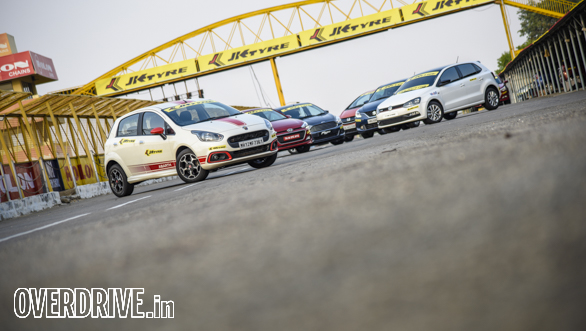
Who is Aditya Patel?
From taking the national karting championship by storm, to competing in wings and slicks cars, and finally carving a path out for him in tintop racing, Aditya Patel has come a long way in motorsport. And he's managed to do this with a measure of self-belief and level headedness too. One of the first Indian drivers to successfully chart out a career path in terms of sportscar racing, he's had quite a few highpoints in his career, one of which was winning his category at the 24 Hours of Nurburgring in 2012. Since then, he's competed in the ADAC GT Masters series and the International GT Open before making the switch to racing in Asia. Supported by Audi India, he's now set for his second season in the Audi R8 LMS Cup, after fighting for the championship last year, and eventually finishing fourth. Aditya's immense experience and his ability to identify the minute details that make for an fun car made him the perfect choice for our professional driver in this test!
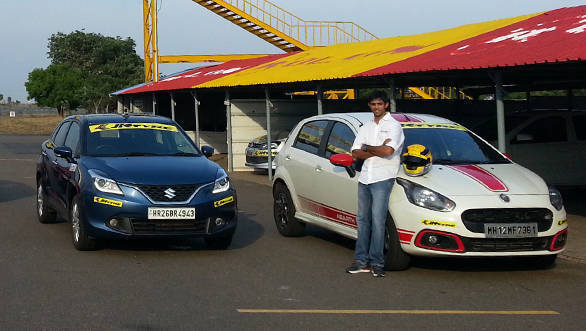
Click on the model names below to see the individual track test reports of all hatchbacks
1) Maruti Suzuki Baleno
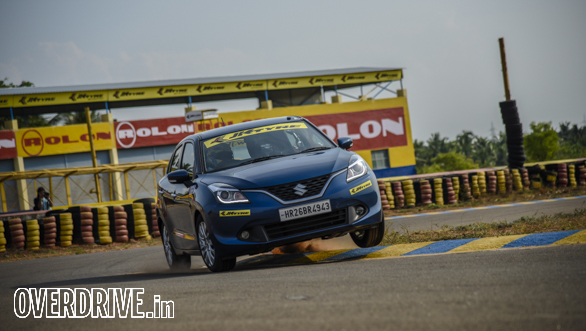
Like the Hyundai i20 and the Honda Jazz, the Baleno is an all-new car. It bettered both in our comparison test earlier but can it continue to finish on top at a racetrack? Honestly, I anticipated the Baleno to do the same at Kari too, but it went on to exceed our expectations. The car feels the most connected when compared to the others and changes direction really well. The chassis stays planted and makes the driver feel a lot more confident about pushing the car harder around the track. The brake feel isn't as good as the Jazz but is good enough for track days. ABS is slightly intrusive, but it is possible to turn into corners without the system kicking in. This is something the i20 cannot do and is another reason why Hyundai is slower around Kari.
The steering is like the Swift and amongst the best in a hatchback today. It complements the light and grippy chassis. The chassis itself is much lighter. In fact, the Baleno diesel is almost 250kg lighter than the i20 diesel â"â" that's the weight of four average-sized adults. Despite featuring the least powerful diesel engine on paper, the Baleno beats the Jazz diesel and i20's lap time around Kari.
Things would have been a lot more interesting if it featured the more powerful 90PS engine. The petrol Baleno is the lightest hatchback here and also the quickest around the lap in this test when compared to its naturally aspirated petrol rivals. The gearbox has short throws that are also precise, making it a delight to use, especially on a racetrack.
Aditya felt that the Baleno is the car that he'd happily drive around Kari all day long. It was also the choice for people driving for the first time on a racetrack. Rishabh was one of them and he managed to get within two seconds of Aditya's laptime. The Baleno is proof that a low kerb weight and a well-tuned chassis can make a car much quicker around a racetrack. Can't wait, then, for the more powerful Baleno BoosterJet to roll out in India.
Maruti Suzuki Baleno technical specifications
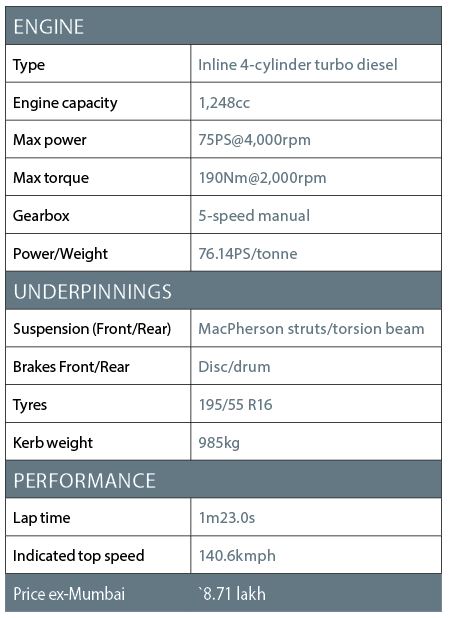
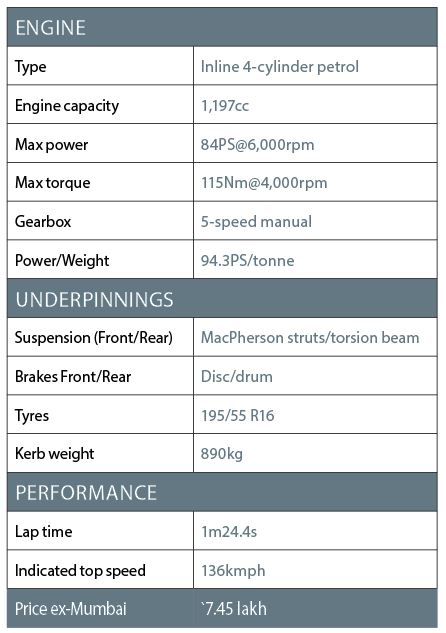
Split times:
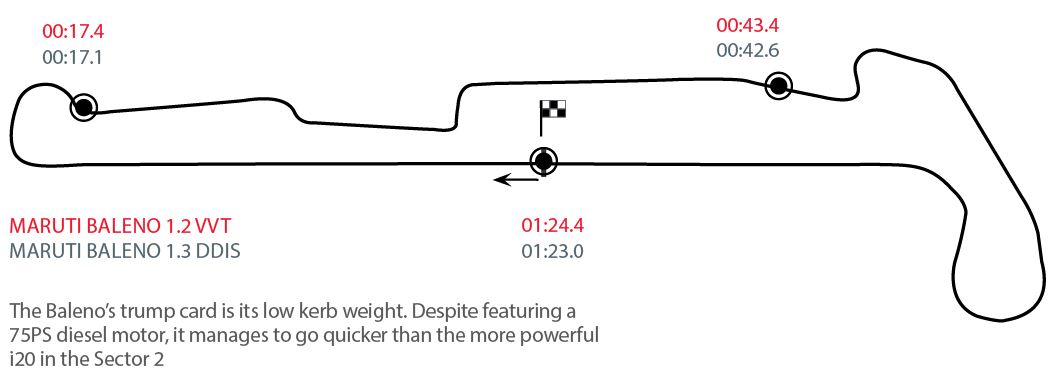
Tester's notes:
Bertrand D'souza: Another sweet car, and I'm slowly beginning to see how the new crop of Marutis or rather Suzukis with their European aspirations are beginning to appeal more to me. Yes, the suspension could do with some more tweaking and strengthening. The engines could be more powerful, and the diesel is in a league above the petrol without a doubt. But I'm hoping the forthcoming BoosterJet takes care of some of these limitations this otherwise fun car has.
Rishaad Mody: This one surprised. I didn't expect much from the Baleno, but it ended up being among the nicest to drive. The petrol engine is crisp and the happiest to rev. Even the plucky little 75PS diesel engine wasn't outclassed. The light chassis definitely helped, but small things like the seating position and steering feel contributed to this being one of the favourites all weekend. I loved the gearbox as well â" short and precise throws in both the petrol and diesel.
2) Honda Jazz
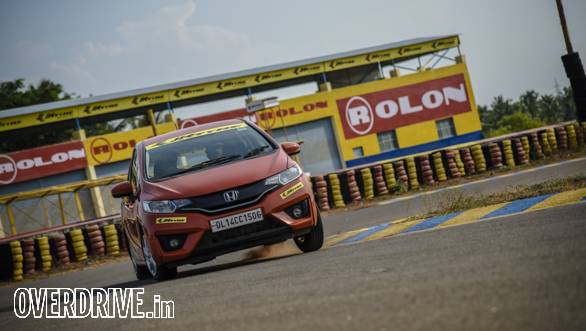
The Honda Jazz is known for its versatility, and the new-generation model is no different. The centrally-positioned fuel tank helps liberate more cabin space while also making it a well-balanced chassis. The Jazz has always been the tuner's favourite compact, especially in Japan and USA. The culprit there and, a lot more in India, is the engine. It lacks outright power, and both the i-VTEC and i-DTEC mills don't feel like they produce 90PS and 100PS respectively. The petrol unit produces peak power and torque higher up the rev range. Add taller gear ratios to this, and the Jazz could only be fast around the corners in second gear. Shift to third and the engine loses steam but not as much as the Hyundai i20 petrol. The steering feel is better compared to the rest, and it's quite precise too. The car flows well into the corners and is very responsive when it comes to weight transfer despite the skinny 175-section tyres and slightly heavy steering. The petrol Jazz has a neutral chassis that can be provoked to either under or oversteer. The petrol is our choice when it comes to chassis feel, the diesel being heavier and lazier.
The other highlight of the Jazz that we realized after driving on the track is the car's braking ability. It offers the best brake feel among all the hatchbacks here, and one can brake much later before entering the corner. ABS doesn't interrupt at all, so this also meant one could brake harder. Vital seconds saved then, but it's still not enough for a good lap time. The Jazz petrol went on to shock us when it crossed the start/finish line, as the VBOX displayed 1m26.69s, making it the slowest car of the lot. The Jazz diesel, however, does better, despite being heavier than its petrol sibling. It's a full two seconds quicker around the 2.1km track. DTEC just kicked in yo! But when you pitch it against the other diesels, it loses out in the lap time battle. Despite having a higher top speed, it just isn't able to carry that speed around corners.
Honda Jazz technical specifications
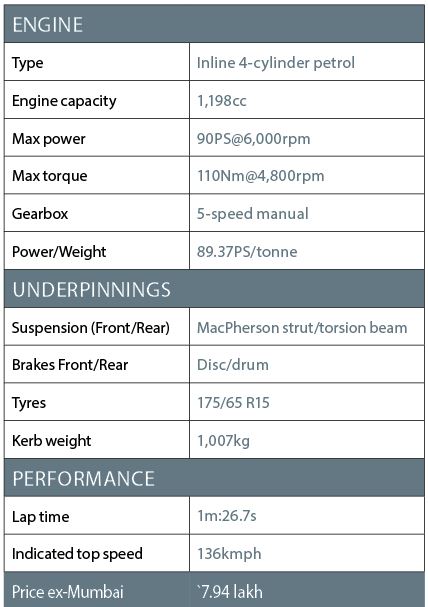
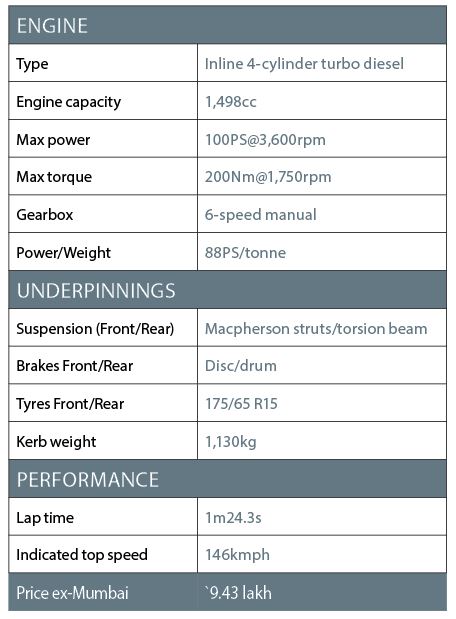
Split times:
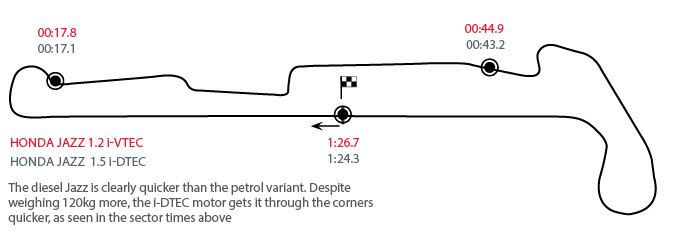
Tester's notes:
Bertrand D'souza: Not too bad for a car that I've noticed is hugely popular with lawyers and dentists. It's for those who practice patience â" unfortunately on a racetrack we have none. It's got powerful engines, but these are more attuned to operating as workhorses. Yup, if Honda spices up the drivetrain, especially getting in a better transmission and a little more power, the Jazz would drive just as impressively as that orange version looks!
Rishaad Mody: The Jazz displayed the biggest difference in chassis feel between petrol and diesel siblings in this group. The petrol chassis feels lighter, turns in better and even allows you to back it in slightly on corner entry. Ultimately, the 1.2 petrol, while better than the Hyundai i20, still doesn't have the guts for the track. The diesel is quicker but feels heavier. Despite boasting the same 100PS, it doesn't pull with the same conviction through the gears as the Ford.
3) Ford Figo
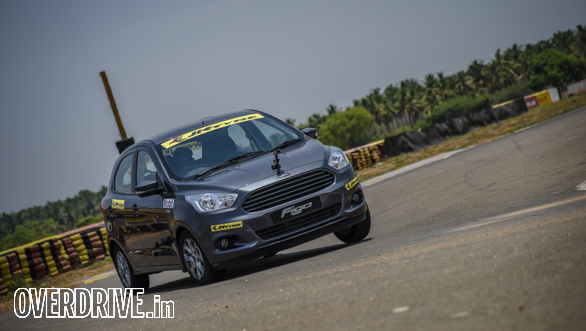
The first-generation Figo is still one of the best handling hatchbacks India has seen so far. After all, it's a Fiesta Mark V underneath. The new Figo uses an updated platform based on the older Figo but gets engines that are a lot more powerful. We decided to test the 1.5-litre petrol model. The former is the second car in this test after the Volkswagen Polo GT TSI to use an automatic transmission. The petrol motor puts out 112PS at a rather high 6,300rpm. The gearshifts are slow despite featuring a dual-clutch transmission. Like the Polo, the gearbox takes time to offer a downshift, taking the fun right out of an otherwise capable petrol motor. The Figo uses two tiny buttons on the right side of the gear knob actuated by using your left thumb. This meant we had to one-hand steer while trying to downshift before corner entry. The delay in downshifting meant one had to keep clicking the gear change button repeatedly before the system finally decided to drop a gear. This also piles on a few seconds, which means the whole point of shifting manually is wasted!
The steering is more vague than the Hyundai i20 on the racetrack. Aditya found the steering to be positioned a bit ahead too. The traction control system is way too intrusive even when turned off. It's a great chassis and could have been better if the system turned off completely. Braking is weak and the rear end of the car tends to move around while doing so. It isn't a sensation one likes to experience, especially when one is braking from triple-digit speeds to a slow corner like C1 at Kari. Add to that an ABS unit that intervenes way too early and you're left being too gentle on the brakes with laptimes taking a massive hit. Despite the slow transmission, the high power to weight ratio makes the Figo petrol quicker than the i20 and Jazz petrol. But why are you reading about the car towards the end of this comparison?
That's because this test also features the diesel-powered Figo. It also features a 1.5-litre motor and it puts out 100PS of max power and 215Nm of torque available from a low 1,750rpm. There's no traction control system, and it uses the same nimble chassis as its petrol sibling. Around Kari, the car feels the lightest among the diesels and pulls well out of corners even in third gear. Power delivery is strong throughout the rev range. Despite smaller and narrower tyres than the rest, the car grips surprisingly well. The Figo diesel oversteers slightly on corner entry and then understeers at the exit, making it quick around the track. It isn't the most entertaining car of the lot, but I found myself driving this car around the track the most. And then everyone else fought for the keys as the Figo diesel went on to surprise everyone by beating the Punto Abarth by 0.1 seconds! The even bigger surprise was that the diesel Figo matched the Fiat Punto Abarth's 151kmph top-speed down the main straight. Never has there been a better example of David taking down Goliath!
Ford Figo technical specifications
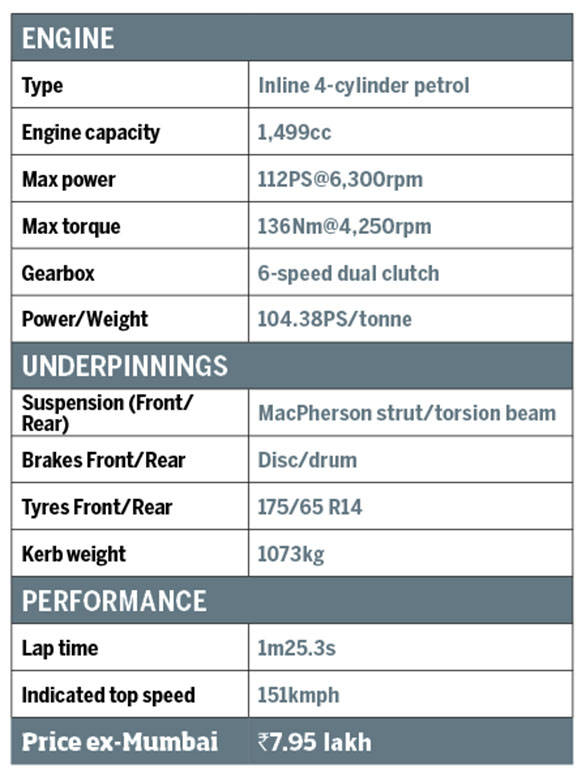
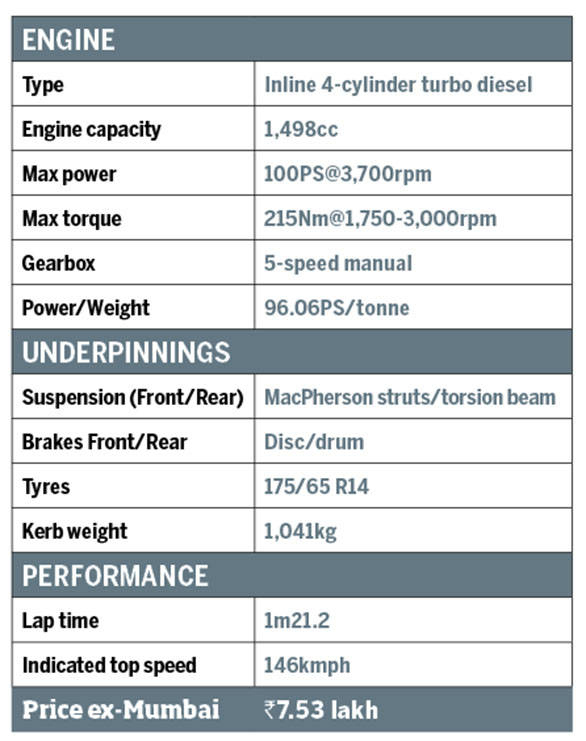
Split times:
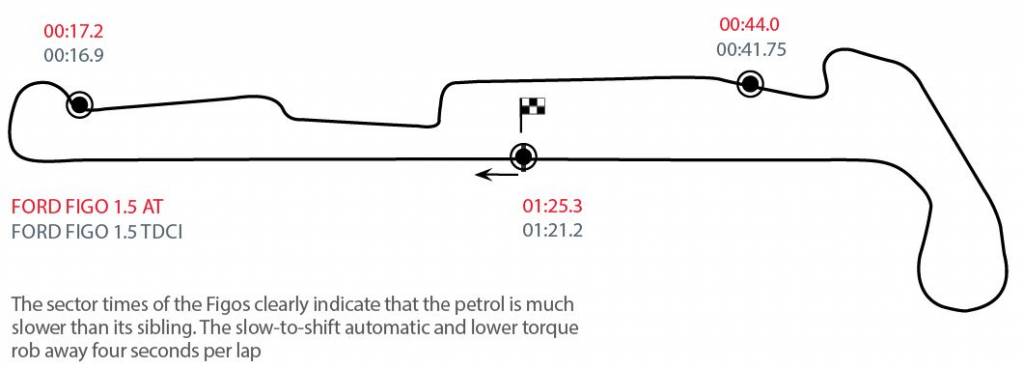
Tester's notes:
Bertrand D'souza: Now here is a curious case of one brand whose variants sit poles apart. The petrol Figo seems a laggard but is in reality let down by that terrible gearbox, and it's supposed to be a dual-clutch automatic. The chassis otherwise is phenomenal. It's easy to see how that chassis and the diesel powertrain easily match up to get the quickest times on this test. Of course, it also helps if that chassis allows you to transition through the corners in the smoothest manner possible. Minimum fuss, maximum output!
Rishaad Mody: Both the Figos have a lovely chassis set-up with great front end feel and a rear that isn't shy to move around. The petrol is let down by its gearbox that simply doesn't want to downshift and a traction control system that refuses to fully turn off. The diesel though feels far more powerful than the numbers suggest and never needed less than third gear. The only negatives are the artificially light steering feel and overenthusiastic ABS. Still, none of us expected it to go so fast. Well done!
4) Fiat Punto Abarth
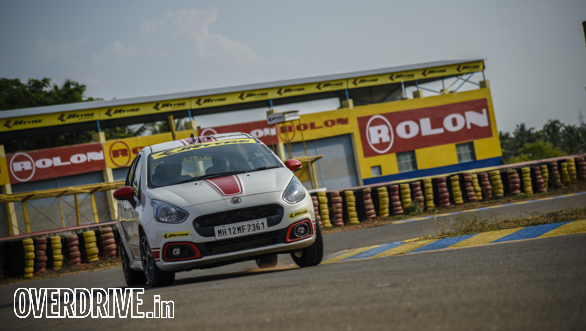
The Punto Abarth produces 145PS and 212Nm of torque making it the most powerful car available in India under `10 lakh by far. This also means that it sits on top of the power pyramid in this test. While most Indian carmakers prefer to add styling parts from their performance division, Fiat did more. They took a stock Punto, reduced the car's ride height, gave it better brakes all around and added the well-known 1.4-litre Abarth tuned T-Jet motor into the bay. While it isn't exactly the same spec as the Punto Abarth that was available internationally, it still is a quick hatchback.
On the Kari Speedway, it's the only petrol car to cross the 150kmph mark on the main straight. It turns in well too. The direction change is quick but then the car tends to understeer. Since the car displayed more body roll than expected, Aditya found that the Punto responded better to an aggressive turn-in. Around corners, you need to be very patient till you're pointing towards the exit as only then you can step harder on the throttle leading to a quick lap time. One also has to short shift to avoid wheel spin. The suspension may be lower than a stock Punto, but it still is soft for a car that's this fast. The stock tyres as well as JK Tyre's Vectra end up being eaten faster than on the other cars here.
Fiat doesn't have any information for us on the uprated brakes, but we think it's the same all-round disc package from the Linea T-Jet. Braking is respectable but not in the same league as the Honda Jazz. The seating position is poor and the seats offer very little support. The only highlight then is the turbo motor. It is great fun on the racetrack as well as on the highway. The car is quicker than all the other petrol hatchbacks by a huge margin. While the Fiat officials don't have a kerb weight to give us, we assume the car should weigh about 1,200kg considering a standard base Punto petrol weighs 1,144kg.
However, the car begs for a few more add-ons like LSD, stiffer and a more lowered suspension set-up as well as stickier rubber. This desi Abarth then definitely has the potential to become a true international spec hot hatch.
Fiat Punto Abarth technical specifications
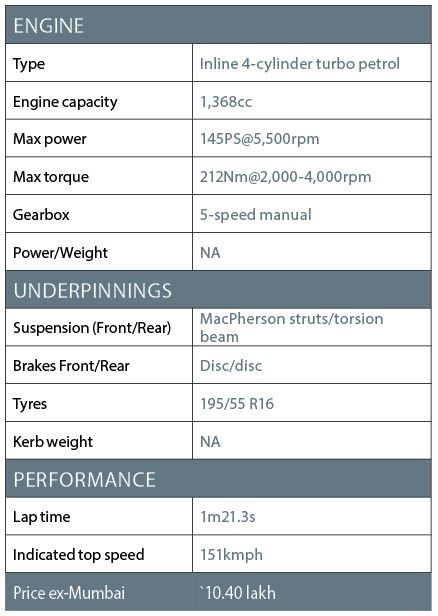
Split time:

Tester's notes:
Bertrand D'souza: What a rocket! The Punto may be one of the least sold cars on the planet, but with the Abarth configuration it's an absolute gem. The pace it sets is blistering. Ideally, if you're looking for a hot hatch, the Punto Abarth is the one you should invest in, along with a really good set of tyres. Spellbinding!
Rishaad Mody: The expectations were high with the Punto and it delivered, mostly. The powerful engine is the absolute star here, but the suspension is just not up to handling all that grunt. It's lower than a standard Punto but feels too soft for this application. The result is considerable torque steer and immense waste of power through wheelspin on corner exits. There's huge potential, but the Punto badly needs better suspension and a bucket seat â" the driving position is awful.
5) Hyundai Elite i20
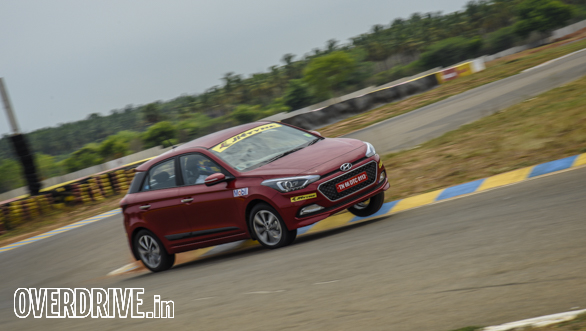
We never were fans of the previous i20, but the new-generation Elite i20 changed all of that. While its predecessor was more of a town car, the Elite can put a smile on your face even when driven enthusiastically. We were impressed with the car during our road test. Turns out it's as exciting to drive even on the racetrack. The i20 displays great mechanical grip. In fact, the chassis is one of the best when compared to the rest in this test. Dynamics has improved several notches and Hyundai seems to have taken feedback seriously. Overall grip is better than the others through vital corners, especially C1, C2 and the bowl at Kari Speedway. Body roll is controlled and the suspension is well-balanced making the car ride nicely over the kerbs and bumpy sections of the track.
However, the i20 petrol's gearing isn't best suited to the track. Power bogs down rapidly when shifting at redline from second to third gear. It's also the heaviest naturally aspirated petrol car in this test. The lap time could have been a few seconds quicker if it wasn't for the weak motor and gearing. This is where the diesel i20 steps in. The added torque from the 1.4-litre CRDi engine and better power delivery means one doesn't have to shift gears that often. Power delivery from the turbocharged motor is stronger and corner exits are a lot faster. Aditya found that the inner tyre gripped better in the diesel, thanks to the added load. These points make the diesel Elite i20 quicker than its petrol sibling by a whopping 2.6 seconds around Kari. It's also one of the quickest diesel hatchbacks in this test.
However, brake feel and performance isn't impressive â" every other car you see here offers superior braking. The ABS kicks in much earlier than expected, and one needs to modulate the brakes to find the right balance. Another negative is the steering. There is hardly any feedback from the unit and there's quite a bit of play as well. Seating position is fine but support could have been enhanced.
Hyundai Elite i20 technical specifications
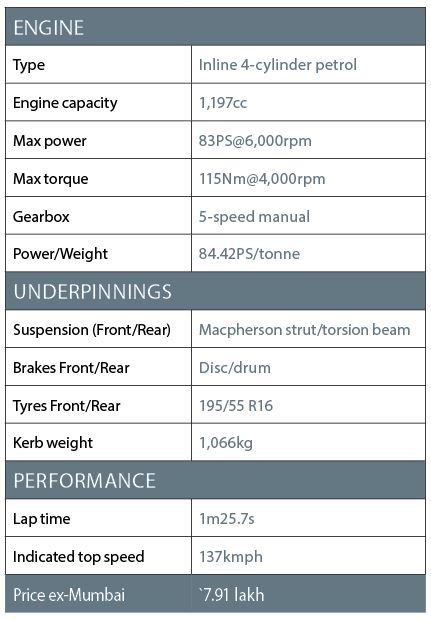
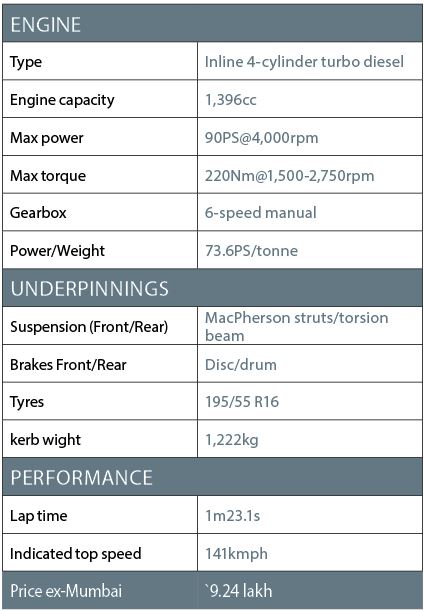
Split times:
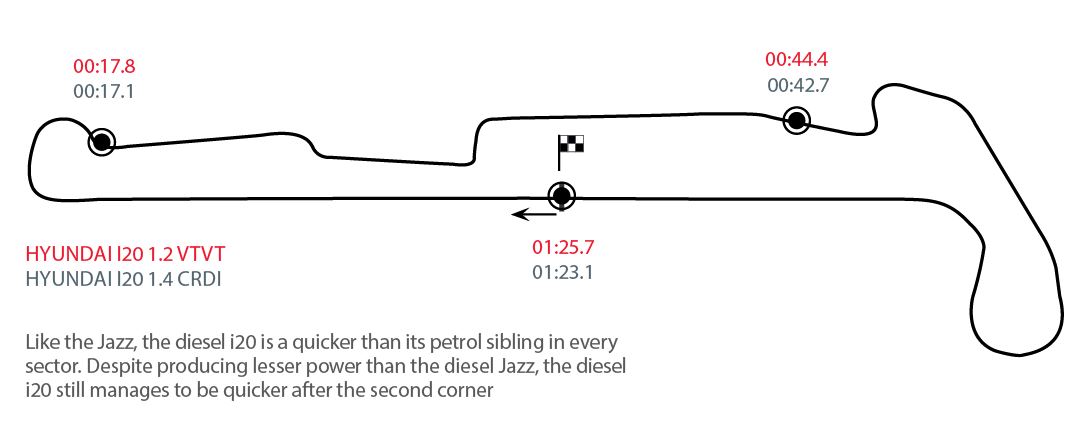
Tester's notes:
Bertrand D'souza: I went with the assumption that the i20 would be quite disappointing. But I came away thinking this was easily the silkiest car I've ever driven on the boil on a racetrack. With one of the best chassis set-ups, the only drawback is a lack of serious horsepower to give it that edge. Here's an idea Hyundai, drop in the 1.6, then see it fly!
Rishaad Mody: I've always been a fan of this chassis. It corners with remarkably little roll, and the front end somehow finds mid corner grip where the others simply cannot. The petrol engine, however, is far too weak and it bogs when shifting from the redline in second to third. The diesel is far better but feels far less powerful than the 10PS difference to the diesel Figo would suggest. Lifeless steering is the final nail in the coffin for the i20's track aspirations.
6) Volkswagen Polo GT TSI
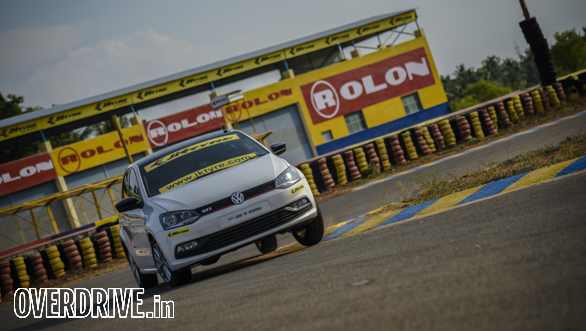
Among the hatchbacks you see here, the Volkswagen Polo is among the hottest you can get today. It's a European favourite. In India, it even gets a powerful turbocharged petrol or diesel motor. Volkswagen couldn't give us the GT TSI or the GT TDI for this test, but a friend of ours didn't mind lending us his GT TSI.
We are big fans of this little Volkswagen and were sure that the car would be quicker around the track by quite a margin over the other petrols. Sadly, it didn't turn out that way. The TSI motor revs quick and the twin-clutch transmission shifts rapidly too. The car is 10-15kmph faster down the straight when compared to the naturally aspirated petrols. However, before entering a corner, the transmission refuses to give you those important downshifts. This is a big downer especially when one has to drastically slow down on the main straight before entering C1. Aditya also mentioned that only after multiple downward shifts on the gear selector, it finally dropped a gear. The traction control system cannot be turned off completely either. We say this, as it was a bit intrusive even after deactivating the system.
While it rides well on Indian roads, the fact that the car has been made softer for our market also makes it bumpy over the many undulating sections at Kari. There's more body roll than expected, but it isn't unstable at any point. The steering is quite direct and gets heavier as you load it too. It is the best unit when it comes to overall feel. Aditya, however, felt that it could have been a little more responsive on corner entry. It's a pity that the GT TSI, despite being a entertaining car to drive on public roads, is only three tenths of a second quicker than the Baleno petrol on the racetrack.
Volkswagen Polo GT TSI technical specifications
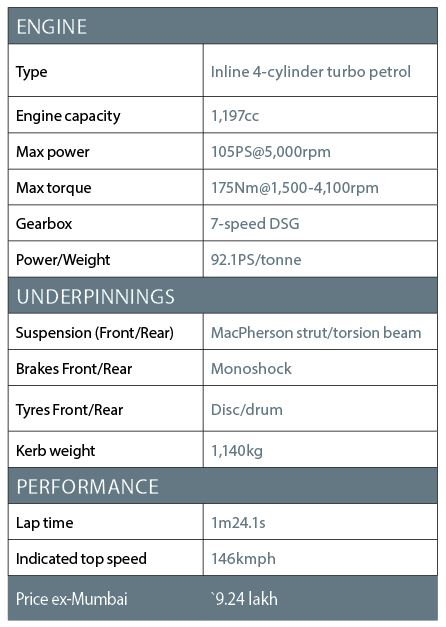
Split time:

Tester's notes:
Bertrand D'souza: An entirely predictable hatchback, the Polo is precise around a racetrack. Quick steering and throttle response â" it's got it all except for an transmission that refuses to downshift when needed. If the GTI ever makes it to India, it would be awesome. In the interim period though the GT TSI is just a lukewarm appetiser!
Rishaad Mody: What proves to be an engaging and enjoyable road car just wasn't up for it on the racetrack. The gearbox shifts up quickly and smoothly but doesn't want to give you those hard downshifts on corner entry. The 1.2-turbo petrol has a punchy mid-range and would have probably fared much better with a manual here. Ultimately, the soft chassis has high levels of grip but also rolls quite a bit. This isn't a problem but it doesn't feel very sporty either.
The final word
After two days of non-stop driving and countless plates of biryani consumed, we now know that each car in this test has a desirable trait that we love. It also highlights the fact that each of them has traits that we aren't fans of. It's a sort of unintentional balance across the playing field â"â" a somewhat perfect recipe for a tin-top racing series, if you will. More importantly, this begs the question â"â" what if there existed a car with the chassis of a Figo, the front-end grip of an i20, steering from a Polo, brakes from a Jazz and the motor from the Abarth mated to the Baleno's smooth transmission. Comes damn near close to perfect, that. Unfortunately, we're still to find this unicorn of a car.
We went into this test sure that that Punto was going to win. But there are many holes in its armour that takes the win away from the capable engine. Merely better rubber would have made it quicker than the Figo. And don't even get us started on the list of aftermarket parts that would make it even better. However, this would mean spending money on an already expensive car. The Punto Abarth only makes sense if you have a higher budget and don't mind spending a few more lakhs in ironing out its problems. However, if you don't have that kind of money, the Figo diesel is undoubtedly the best hot hatch available under `10 lakh in India today. Plus, with that 2.5-odd lakhs that you save over the Fiat, you can make your already fast Ford even faster.
All hatchbacks in our track test were running on JK Tyre Vectra tyres and were using Mobil1 synthetic oil
Starts Rs 2.55 Crore
5204cc
Automatic
610
530
7.63 Kmpl
Starts Rs 7.75 Lakhs
1194cc
Automatic
96
119
16 Kmpl
Starts Rs 7.5 Lakhs
1199cc
Automatic
90
110
17.1 Kmpl
Starts Rs 5.5 Lakhs
1396cc
Manual
83
220
22.54 Kmpl
Starts Rs 6.8 Lakhs
1493cc
Manual
83
241
-NA-
Starts Rs 6.35 Lakhs
1197cc
Manual
90
113
22.94 Kmpl
Starts Rs 38 Lakhs
1998cc
Automatic
231
320
15.81 Kmpl
Starts Rs 6.17 Lakhs
999cc
Automatic
110
175
16.47 Kmpl










